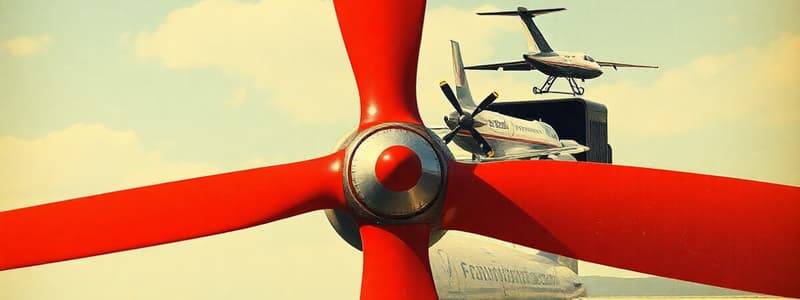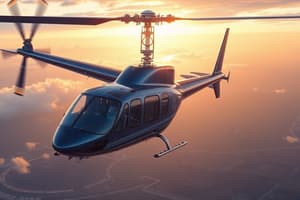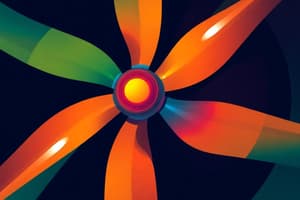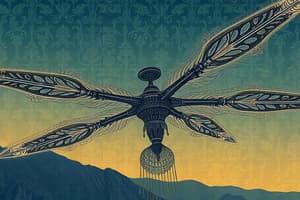Podcast
Questions and Answers
What should be done with a rotor blade that has incurred nonrepairable damage?
What should be done with a rotor blade that has incurred nonrepairable damage?
- Attempt to repair it on-site
- Send it back to the manufacturer for evaluation
- Store it for future reference
- Condemn and dispose of it locally (correct)
How should you protect the blade's interior from moisture and corrosion?
How should you protect the blade's interior from moisture and corrosion?
- Cover with a plastic wrap
- Submerge in oil
- Apply a sealant around all edges
- Tape all holes in the blade (correct)
What type of coating should be applied to the blade's outboard eroded surfaces?
What type of coating should be applied to the blade's outboard eroded surfaces?
- Corrosion preventive or primer coating (correct)
- Heavy-duty paint
- Regular varnish
- Engine oil
What is required to be placed in the waterproof bag during rotor blade storage?
What is required to be placed in the waterproof bag during rotor blade storage?
Which information should be stenciled on the outside of the rotor blade container?
Which information should be stenciled on the outside of the rotor blade container?
What effect does subtracting weight have on the center of gravity?
What effect does subtracting weight have on the center of gravity?
What is one consequence of blades failing to track correctly?
What is one consequence of blades failing to track correctly?
How can a repairer align blades in the same plane of rotation?
How can a repairer align blades in the same plane of rotation?
What is a trim tab used for in rotor blade construction?
What is a trim tab used for in rotor blade construction?
What happens when a trim tab is bent up?
What happens when a trim tab is bent up?
What is a cheaper alternative to using tracking weights for blade alignment?
What is a cheaper alternative to using tracking weights for blade alignment?
What is the purpose of bonding in blade construction?
What is the purpose of bonding in blade construction?
What may be the outcome of vibrations caused by misaligned blades?
What may be the outcome of vibrations caused by misaligned blades?
Which part of a blade is most likely to have holes drilled?
Which part of a blade is most likely to have holes drilled?
What role do tracking weights play in blade performance?
What role do tracking weights play in blade performance?
What can careless use of paint thinners and cleaning solvents do to bonded joints?
What can careless use of paint thinners and cleaning solvents do to bonded joints?
What is the faying surface in the context of blade construction?
What is the faying surface in the context of blade construction?
When manufactures install mass balance weights, what is the intended chordwise balance percentage?
When manufactures install mass balance weights, what is the intended chordwise balance percentage?
What effect does adding spanwise weight have on the center of gravity?
What effect does adding spanwise weight have on the center of gravity?
Why is the movement of weights restricted for most helicopter blades during repairs?
Why is the movement of weights restricted for most helicopter blades during repairs?
What type of weights are typically installed at the tip of the blade?
What type of weights are typically installed at the tip of the blade?
What material is used to cover the exterior surface of certain rotor blades?
What material is used to cover the exterior surface of certain rotor blades?
What is a distinct advantage of metal rotor blades?
What is a distinct advantage of metal rotor blades?
How are wooden rotor blades typically constructed in pairs?
How are wooden rotor blades typically constructed in pairs?
What component is typically included at the leading edge of a metal rotor blade?
What component is typically included at the leading edge of a metal rotor blade?
What is a common property of all rotor blades mentioned?
What is a common property of all rotor blades mentioned?
What issue can arise with wooden rotor blades due to moisture?
What issue can arise with wooden rotor blades due to moisture?
What allows for single blades to be changed independently in metal rotor blades?
What allows for single blades to be changed independently in metal rotor blades?
What feature helps protect the leading edge of wooden rotor blades?
What feature helps protect the leading edge of wooden rotor blades?
What is a common characteristic of most rotor blades?
What is a common characteristic of most rotor blades?
What is the function of building a 3° upward angle into the trailing edge of an asymmetrical airfoil blade?
What is the function of building a 3° upward angle into the trailing edge of an asymmetrical airfoil blade?
Which materials are commonly used in the construction of rotor blades?
Which materials are commonly used in the construction of rotor blades?
What is a major advantage of asymmetrical airfoil blades compared to symmetrical ones?
What is a major advantage of asymmetrical airfoil blades compared to symmetrical ones?
What was the material used for the first production rotor blades?
What was the material used for the first production rotor blades?
Which of the following statements about aerodynamic stability is correct?
Which of the following statements about aerodynamic stability is correct?
Which type of wood was NOT mentioned as used in the construction of early rotor blades?
Which type of wood was NOT mentioned as used in the construction of early rotor blades?
What technological advancement follows the use of metal blades in rotor construction?
What technological advancement follows the use of metal blades in rotor construction?
What is the primary purpose of tail rotor blades?
What is the primary purpose of tail rotor blades?
What material are metal tail rotor blades primarily made of?
What material are metal tail rotor blades primarily made of?
Which component is commonly used to support metal blade skins from the inside?
Which component is commonly used to support metal blade skins from the inside?
What type of extrusions are used for the spars in fiberglass tail rotor blades?
What type of extrusions are used for the spars in fiberglass tail rotor blades?
How is spanwise balance achieved on some rotor blade models?
How is spanwise balance achieved on some rotor blade models?
What does trammeling ensure in fully articulated tail rotor systems?
What does trammeling ensure in fully articulated tail rotor systems?
What is the shape of the spars in fiberglass blades?
What is the shape of the spars in fiberglass blades?
What is typically filled around the spar in fiberglass blades?
What is typically filled around the spar in fiberglass blades?
Flashcards
Fiberglass Rotor Blades
Fiberglass Rotor Blades
Made from fiberglass cloth coated with resin, offering a durable and lightweight construction.
Stainless Steel Leading Edge Protection
Stainless Steel Leading Edge Protection
A significant portion of the leading edge is protected by a stainless steel cap to prevent wear and tear from air friction.
Matching Pairs of Wooden Blades
Matching Pairs of Wooden Blades
Many blades are paired because of the natural variations in wood, ensuring balanced flight characteristics.
Moisture and Wooden Blades
Moisture and Wooden Blades
Signup and view all the flashcards
Hollow Aluminum Spar in Metal Blades
Hollow Aluminum Spar in Metal Blades
Signup and view all the flashcards
Quality Control in Metal Blades
Quality Control in Metal Blades
Signup and view all the flashcards
Interchangeable Metal Blades
Interchangeable Metal Blades
Signup and view all the flashcards
Life Limit of Metal Blades
Life Limit of Metal Blades
Signup and view all the flashcards
Faying surface
Faying surface
Signup and view all the flashcards
Bonding in blade construction
Bonding in blade construction
Signup and view all the flashcards
Solvents and bonded joints
Solvents and bonded joints
Signup and view all the flashcards
Blade balance
Blade balance
Signup and view all the flashcards
Mass balance weights
Mass balance weights
Signup and view all the flashcards
Spanwise balance weights
Spanwise balance weights
Signup and view all the flashcards
Spanwise weight and center of gravity
Spanwise weight and center of gravity
Signup and view all the flashcards
Mass balance weights and chordwise balance
Mass balance weights and chordwise balance
Signup and view all the flashcards
Symmetrical Airfoil Rotor Blades
Symmetrical Airfoil Rotor Blades
Signup and view all the flashcards
Aerodynamic Stability in Symmetrical Blades
Aerodynamic Stability in Symmetrical Blades
Signup and view all the flashcards
Asymmetrical Airfoil Rotor Blades
Asymmetrical Airfoil Rotor Blades
Signup and view all the flashcards
Aerodynamic Stability in Asymmetrical Blades
Aerodynamic Stability in Asymmetrical Blades
Signup and view all the flashcards
Rotor Blade Materials
Rotor Blade Materials
Signup and view all the flashcards
Wooden Rotor Blades
Wooden Rotor Blades
Signup and view all the flashcards
Metal Rotor Blades
Metal Rotor Blades
Signup and view all the flashcards
Composite Rotor Blades
Composite Rotor Blades
Signup and view all the flashcards
Weight Change and Center of Gravity
Weight Change and Center of Gravity
Signup and view all the flashcards
Plane of Rotation
Plane of Rotation
Signup and view all the flashcards
Consequences of Bad Tracking
Consequences of Bad Tracking
Signup and view all the flashcards
Tracking Weights
Tracking Weights
Signup and view all the flashcards
Location of Tracking Weights
Location of Tracking Weights
Signup and view all the flashcards
Trim Tabs
Trim Tabs
Signup and view all the flashcards
Effect of Bending Trim Tab Upward
Effect of Bending Trim Tab Upward
Signup and view all the flashcards
Effect of Bending Trim Tab Downward
Effect of Bending Trim Tab Downward
Signup and view all the flashcards
Condemning Damaged Blades
Condemning Damaged Blades
Signup and view all the flashcards
Protecting the Blade Interior
Protecting the Blade Interior
Signup and view all the flashcards
Clean Rotor Blades Thoroughly
Clean Rotor Blades Thoroughly
Signup and view all the flashcards
Protecting Exposed Blade Surfaces
Protecting Exposed Blade Surfaces
Signup and view all the flashcards
Secure Blade Packaging
Secure Blade Packaging
Signup and view all the flashcards
Metal Tail Rotor Blades
Metal Tail Rotor Blades
Signup and view all the flashcards
Fiberglass Tail Rotor Blades
Fiberglass Tail Rotor Blades
Signup and view all the flashcards
Metal Blade Construction
Metal Blade Construction
Signup and view all the flashcards
Fiberglass Blade Construction
Fiberglass Blade Construction
Signup and view all the flashcards
Spanwise Balance
Spanwise Balance
Signup and view all the flashcards
Chordwise Balance
Chordwise Balance
Signup and view all the flashcards
Trammeling
Trammeling
Signup and view all the flashcards
Trammeling Process
Trammeling Process
Signup and view all the flashcards
Study Notes
Rotary Wing Aerodynamics
- AVIA-1035 course
- Presented by FANSHAWE
Rotor Blades
- Designs and construction vary by manufacturer, but all aim for efficient, economical lifting.
- Helicopter design requirements influence blade design & construction.
Rotor Blade Design
- Symmetrical airfoils are standard to create stable aerodynamic pitching.
- Stability achieved when center of gravity, center of pressure, and feathering axis align.
- Blade stays stable in flight because the forces remain aligned as pitch changes.
- Asymmetrical airfoils are gaining popularity, offering greater lift than symmetrical models of equivalent size.
- Stability achieved by building a 3° upward angle into the trailing edge.
- This prevents excessive center-of-pressure movement during angle of attack changes.
Rotor Blade Materials
- Common materials include aluminum, steel, brass, and fiberglass.
- Early blades were made of wood, some still in use.
- Metal blades followed, then composite blades utilizing various materials, representing the newest blade type.
Wooden Rotor Blades
- First production blades were laminated wood (birch, spruce, pine, and balsa).
- Combinations used to achieve needed strength and aerodynamics.
- Steel core near leading edge.
- Outer surface covered with resin-impregnated fiberglass cloth.
- Two-thirds of outer leading edge covered with stainless steel cap for abrasion protection.
- Often used in matched pairs due to wood variations.
- Susceptible to moisture.
Metal (Aluminum) Rotor Blades
- Over 40 years in use; construction varies significantly between manufacturers.
- A typical metal blade includes a hollow, extruded aluminum spar creating the leading edge.
- Single blades can be changed without needing a matched pair.
- Aluminum pockets bonded to the trailing edge for streamlining.
- Aluminum tip cap fastened to spar and tip pockets.
- Like other metal dynamic components, likely to be limited in lifespan due to stresses.
Composite Rotor Blades
- Fiberglass or composite blades are the main load-carrying components, often made of fiberglass.
- Fiberglass blade use a procured roving spar, or metal spar.
- Roving (glass material strips) are impregnated with epoxy resin and wound around a foam core.
- Skins are made of fiberglass cloth.
- Root reinforcement plates added.
- Trailing edge includes another roving strip, and fiberglass covered, bonded area.
- The leading edge is protected by a stainless steel covering.
- Balancing weights added by manufacturers.
Rotor Blades - Figure 3-6
- Displays the parts of a typical metal blade with labels for each component.
Rotor Blades - Figure 3-7
- Displays a cross-section and diagram of a composite blade.
Rotor Blades - Figure 3-7 Composite Rovings
- Shows a detailed diagram of the root section of the composite blade.
Rotor Blade Additional Information
- Additional protection added with a rubber erosion strip to bottom.
- A steel socket is threaded into the blade's spar shank for connection to the rotor head.
- Stainless steel tip caps are bolted to spar and tip pockets.
- Internal grounding strips bond electricity to aircraft.
Blade Nomenclature
- The planform is the shape when viewed from above; it can be uniform or tapered.
- Uniform planforms are easier to manufacture because all internal parts are the same size.
Rotor Blades - Figure 3-8
- Illustrates the differences between uniform and tapered planforms.
Rotor Blades - Figure 3-10
- Shows the tip of the rotor blade with markings.
- Attachments for added weight.
Rotor Blades - Figure 3-11
- Shows the leading edge and its significant thickness and protective covering from abrasion.
Rotor Blades - Figure 3-12
- Shows the trailing edge of the rotor blade and its reinforcement.
Rotor Blades - Figure 3-13
- Illustrates the span and span line of the rotor blade.
Rotor Blades - Figure 3-14
- Shows the chord line of the rotor blade.
Rotor Blades - Figure 3-15
- Show different examples of spar designs and their relation to rotor blades, with various material types' spar examples.
Rotor Blades - Doublers
- Rotor blades can use flat plates (doublers) bonded to the root to strengthen them.
- Not all blades use doublers, though, as the spars themselves may already be strong enough.
Rotor Blades - Top
- Low-pressure side viewed from above the helicopter.
- Typically painted olive drab, gray, or black.
Rotor Blades - Bottom
- High-pressure side viewed from below the helicopter.
- Typically painted a matte-black finish.
Rotor Blades - Blade Stations
- Mast is station zero, numbers increase outward to blade tip.
Rotor Blades - Blade Construction - Single Pocket or Fairings
- One-piece skin covers both top and bottom (the 'fairings').
- Fabric extends past the spar.
- Easier and less complex constructions method.
Rotor Blades - Blade Construction - Multiple Pockets or Fairings
- Multiple pockets or compartments within the blades.
- Only the pocket (or fairing) needs to be replaced if damaged, allowing blades use for extended periods.
- More flexible with reduced vibration.
Rotor Blades - Internal Structural Components
- Ribs, I-beams, spanwise channels, and aluminum honeycomb are internal support structures.
Rotor Blades - Bonds and Bonding
- Bonding is a method where parts are joined using adhesives.
- Bonding decreases the need for hardware like bolts, rivets, and screws.
Rotor Blade Construction - However, Bonds React
- Bonds react to the chemical action of solvents such as paint thinners.
- Careless use of such solvents can damage the bonded joints.
Rotor Blades - Figure 3-19
- Depicts the bonding process and the faying surface of the blades.
Rotor Blades - Blade Balance
- Three types of weights are applied: mass, chordwise, spanwise, and tracking.
- Mass balance weights are positioned into the leading edge.
- Ensure that the chordwise balance is about 25 percent of the chord.
Rotor Blades - Figure 3-20
- Shows mass, spanwise, and tracking balance weights on the blade
Rotor Blades - Figure 3-21
- Shows three different examples of balance bars.
Rotor Blades - Blade Construction - The Repairer is Not Allowed
- Repairers are generally prohibited from changing weights.
- Moving weights repositions the center of gravity and effects balance and control.
- Spanwise balance weights are normally attached at the tip.
Rotor Blades - Figure 3-22
- Shows the application of weights to the blade bracket track to adjust its balance.
Rotor Blades - Blade Construction- When Movement Is Necessary
- When necessary to adjust weights, the repairer must account for its effect on the center of gravity.
- Weights are added or subtracted to balance the blade in one direction or another
Rotor Blades - Blade Construction - To Be Efficient
- Blades should track on the same plane for smooth rotation, avoiding damage and comfort reduction.
- Air turbulence from blades can cause a loss of performance.
Rotor Blades - Blade Construction - One Way of Retaining
- Tracking weights are attached to the front or back of the feathering axis at the blade tips.
Rotor Blades - Figure 3-23
- Shows how weights change the track of a rotor blade when applied in specific areas.
Rotor Blades - Blade Construction - Trim Tabs
- Another method using trim tabs to adjust rotor blades on the same plane of rotation
- This often involves adding a metal strip to the trailing edge.
- Trim tabs are employed to adjust the path to ensure proper lift operation.
Rotor Blades - Figure 3-24
- Illustrates the use of trim tabs to adjust the blade's track, showing the up or down adjustment effects.
Rotor Blades - Blade Construction - In Tracking Operations
- To change the leading edge positioning of the blade, adjustment of the trimming tabs.
Rotor Blades - Tail Rotor Blades
- Used exclusively for directional control.
- Similar construction methods as primary rotor blades, but often made of aluminum.
Rotor Blades - Blade Construction - Fiberglass Tail Blades
- These blades are constructed using fiberglass sheets and titanium spars.
Rotor Blades - Figure 3-25
- Displays the main components of fiberglass tail rotor blade, including the spar, channels, and other support areas.
Rotor Blades - Blade Construction - Metal Blades
- Metal blade skins encase the spar, supported with honeycomb and ribs.
- Some smaller blades lack these internal supports.
Rotor Blades - Blade Construction - Fiberglass Blades
- Fiberglass blade skins are wrapped around and bonded to H-shaped titanium spars.
- Supported from the inside, with aluminum honeycomb used to fill the space around the spars.
Rotor Blade Construction - Blade Balance - Spanwise
- Achieves balance by adding or subtracting washers at the blade tips in some designs.
- Other models will instead add washers to the blade-cuff attaching bolts.
- In other designs, chordwise balance is achieved by altering weights at the blade's tips that are placed behind the spanwise balance screws.
Rotor Blade Construction - Blade Balance - Other Models
- Blades may be balanced by adding weights to the trailing edge near the cuff end.
- Fully articulated tail rotor systems must have a trammeling step prior to the balancing procedure.
Rotor Blade Preservation and Storage
- Condemn and dispose of blades with irreparable damage.
- Tape holes to protect from moisture and foreign object damage (FOD).
- Clean blades thoroughly with mild soap and water.
Rotor Blade Preservation and Storage - Blade Protection
- Protect eroded areas of blades with a coating of corrosion preventative or primer.
- Protect any exposed bare metal, including components like bushing and pads, with a coating for corrosion protection.
- Secure the blade in shock-mounted supports and lid during packaging.
Rotor Blade Preservation and Storage - Documents
- Store manufacturer's records in a waterproof bag inside container tubes.
- Eliminate previous markings.
- Stencil the blade's national stock number (NSN), model and serial number.
Rotor Blade Construction - Various aspects
- Modern rotor blades commonly made of metal.
- Rotor blades are balanced to achieve even rotation (e.g., by moving weights or using trim tabs).
Studying That Suits You
Use AI to generate personalized quizzes and flashcards to suit your learning preferences.




